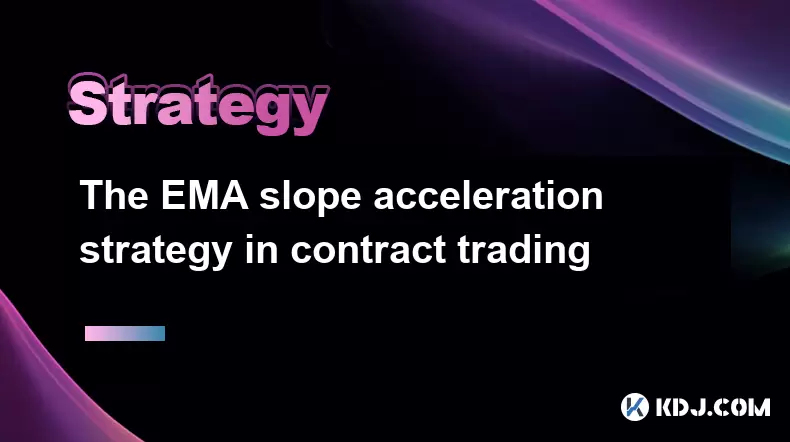-
 bitcoin
bitcoin $114684.631706 USD
-0.87% -
 ethereum
ethereum $4228.677447 USD
1.58% -
 bnb
bnb $1294.880693 USD
-1.16% -
 tether
tether $1.000819 USD
-0.02% -
 xrp
xrp $2.605138 USD
2.79% -
 solana
solana $209.908690 USD
5.89% -
 usd-coin
usd-coin $0.999903 USD
-0.03% -
 dogecoin
dogecoin $0.213423 USD
2.93% -
 tron
tron $0.322721 USD
-0.10% -
 cardano
cardano $0.727247 USD
3.66% -
 hyperliquid
hyperliquid $42.339456 USD
6.05% -
 chainlink
chainlink $19.910811 USD
5.16% -
 ethena-usde
ethena-usde $1.000557 USD
0.00% -
 stellar
stellar $0.349734 USD
2.69% -
 bitcoin-cash
bitcoin-cash $543.848687 USD
-0.21%
The EMA slope acceleration strategy in contract trading
The EMA slope acceleration strategy uses the slopes of fast and slow EMAs to identify trading signals, helping traders determine optimal entry and exit points in crypto markets.
Jun 02, 2025 at 12:42 pm

The EMA slope acceleration strategy is a popular method used by traders in the cryptocurrency contract trading market to identify potential entry and exit points. This strategy leverages the Exponential Moving Average (EMA) to gauge the momentum and direction of price movements. In this article, we will explore the intricacies of the EMA slope acceleration strategy, detailing how it works, how to implement it, and the key considerations traders should keep in mind.
Understanding the EMA and Its Importance in Trading
The Exponential Moving Average (EMA) is a type of moving average that places a greater weight and significance on the most recent data points. This makes the EMA more responsive to new information compared to the Simple Moving Average (SMA). In the context of cryptocurrency trading, the EMA helps traders identify trends and potential reversals by smoothing out price data over a specified period.
The EMA is calculated using the formula:[ \text{EMA}{\text{today}} = (\text{Price}{\text{today}} \times \text{Multiplier}) + (\text{EMA}_{\text{yesterday}} \times (1 - \text{Multiplier})) ]where the Multiplier is ( \frac{2}{\text{Period} + 1} ).
In the EMA slope acceleration strategy, traders typically use two or more EMAs with different periods to generate trading signals based on their slopes and the acceleration of these slopes.
The Basics of the EMA Slope Acceleration Strategy
The core concept of the EMA slope acceleration strategy is to use the slope of the EMA to determine the strength and direction of the trend. The slope of the EMA is the rate at which the EMA line is moving. A positive slope indicates an uptrend, while a negative slope indicates a downtrend. The acceleration of the slope refers to how quickly the slope is changing, which can signal increasing or decreasing momentum.
Traders often use two EMAs with different periods, such as a fast EMA (e.g., 12-period) and a slow EMA (e.g., 26-period), to generate trading signals. The difference in the slopes of these two EMAs can provide insights into potential entry and exit points.
Implementing the EMA Slope Acceleration Strategy
To implement the EMA slope acceleration strategy, traders need to follow a series of steps to set up their charts and interpret the signals correctly. Here is a detailed guide on how to do this:
Select the appropriate time frame: Depending on your trading style, choose a time frame that suits your strategy. For example, short-term traders might use 15-minute or 1-hour charts, while long-term traders might use daily or weekly charts.
Add the EMAs to your chart: In your trading platform, add two EMAs to your chart. For instance, add a 12-period EMA and a 26-period EMA. These are common settings, but you can adjust the periods based on your trading preferences and the asset's volatility.
Calculate the slopes of the EMAs: The slope of an EMA can be calculated manually or using built-in indicators in your trading platform. The slope is essentially the difference between the current EMA value and the previous EMA value divided by the time period.
Monitor the acceleration of the slopes: The acceleration of the slope can be determined by observing how the slope is changing over time. An increasing slope indicates acceleration, while a decreasing slope indicates deceleration.
Identify trading signals: When the fast EMA crosses above the slow EMA and both slopes are increasing, it can be a buy signal. Conversely, when the fast EMA crosses below the slow EMA and both slopes are decreasing, it can be a sell signal.
Interpreting the Signals and Making Trades
Once you have identified the trading signals using the EMA slope acceleration strategy, it is crucial to interpret these signals correctly and make informed trading decisions. Here are some key points to consider:
Confirm the trend: Always confirm the trend with additional indicators or price action analysis. For example, if you see a buy signal, look for bullish candlestick patterns or other technical indicators like the Relative Strength Index (RSI) to confirm the trend.
Set stop-loss and take-profit levels: To manage risk effectively, set stop-loss orders to limit potential losses and take-profit orders to secure profits. The placement of these orders can be based on key support and resistance levels or a fixed percentage of your entry price.
Monitor the market: Continuously monitor the market and adjust your positions as needed. The EMA slope acceleration strategy can provide initial entry and exit points, but market conditions can change rapidly, requiring you to adapt your strategy.
Common Pitfalls and How to Avoid Them
While the EMA slope acceleration strategy can be effective, there are several common pitfalls that traders should be aware of and avoid:
Over-reliance on the strategy: No single strategy is foolproof. Relying solely on the EMA slope acceleration strategy without considering other market factors can lead to poor trading decisions. Always use this strategy in conjunction with other analysis methods.
Ignoring market volatility: Cryptocurrency markets can be highly volatile. The EMA slope acceleration strategy may generate false signals during periods of high volatility. Adjust your strategy and risk management accordingly to account for market conditions.
Failing to adjust the EMA periods: The effectiveness of the EMA slope acceleration strategy can vary depending on the asset and market conditions. Be willing to adjust the periods of the EMAs to better suit the current market environment.
Practical Example of the EMA Slope Acceleration Strategy
To illustrate how the EMA slope acceleration strategy works in practice, let's consider a hypothetical trading scenario using Bitcoin (BTC) on a 1-hour chart:
Setting up the chart: Add a 12-period EMA and a 26-period EMA to the chart.
Identifying a buy signal: Suppose the 12-period EMA crosses above the 26-period EMA, and both EMAs are sloping upwards with increasing acceleration. This could be a potential buy signal.
Confirming the trend: Look for additional confirmation such as a bullish candlestick pattern or a rising RSI to validate the buy signal.
Entering the trade: Enter a long position on BTC at the current market price.
Setting stop-loss and take-profit levels: Place a stop-loss order below a recent swing low to limit potential losses. Set a take-profit order at a key resistance level or a fixed percentage above your entry price.
Monitoring the trade: Continuously monitor the trade and adjust your stop-loss and take-profit levels as the market moves in your favor.
Frequently Asked Questions
Q1: Can the EMA slope acceleration strategy be used for all cryptocurrencies?A1: While the EMA slope acceleration strategy can be applied to most cryptocurrencies, its effectiveness may vary depending on the asset's volatility and liquidity. It is essential to backtest the strategy on different cryptocurrencies and adjust the EMA periods accordingly.
Q2: How do I choose the best EMA periods for the strategy?A2: The choice of EMA periods depends on your trading style and the specific cryptocurrency you are trading. Shorter periods like 12 and 26 are common for short-term trading, while longer periods like 50 and 200 might be more suitable for long-term trading. Experiment with different periods and backtest your strategy to find the best fit.
Q3: Is the EMA slope acceleration strategy suitable for beginners?A3: The EMA slope acceleration strategy can be suitable for beginners, but it requires a good understanding of technical analysis and risk management. Beginners should start with a demo account to practice the strategy without risking real money and gradually move to live trading as they gain more experience.
Q4: How can I combine the EMA slope acceleration strategy with other indicators?A4: The EMA slope acceleration strategy can be combined with other technical indicators such as the RSI, MACD, or Bollinger Bands to enhance its effectiveness. For example, using the RSI to confirm overbought or oversold conditions can provide additional validation for your trading signals.
Disclaimer:info@kdj.com
The information provided is not trading advice. kdj.com does not assume any responsibility for any investments made based on the information provided in this article. Cryptocurrencies are highly volatile and it is highly recommended that you invest with caution after thorough research!
If you believe that the content used on this website infringes your copyright, please contact us immediately (info@kdj.com) and we will delete it promptly.
- XRP Price Prediction: Weekend Rollercoaster or Rally?
- 2025-10-12 08:45:16
- Bittensor (TAO): Super Bullish Signals Point to Potential 2x Rally
- 2025-10-11 10:25:12
- Silver Price Correction: Navigating the Dip & Identifying Key SEO Keywords
- 2025-10-11 10:25:12
- Decoding Crypto Trends: Bittensor's Bull Run, Cardano's Dip, and LivLive's Presale Buzz in 'Uptober 2025'
- 2025-10-12 08:45:16
- MoonBull: The Crypto Meme Coin Promising 1000x Gains?
- 2025-10-11 10:30:01
- Crypto Payroll Revolution: Stablecoins, Altcoins, and the Future of Salary Payments
- 2025-10-11 10:30:01
Related knowledge

Practical parameter settings for a Bitcoin multi-timeframe moving average system
Sep 18,2025 at 10:54pm
Optimizing Timeframe Combinations for Bitcoin Trading1. Selecting appropriate timeframes is crucial when building a multi-timeframe moving average sys...

How can I filter out false breakouts in Dogecoin high-frequency trading?
Sep 22,2025 at 01:00am
Understanding False Breakouts in Dogecoin Trading1. A false breakout occurs when Dogecoin's price appears to move beyond a defined support or resistan...

Techniques for identifying tops and bottoms in the Bitcoin on-chain NVT model
Sep 20,2025 at 07:54pm
Understanding the NVT Model in Bitcoin Analysis1. The Network Value to Transactions (NVT) ratio is often described as the 'P/E ratio' of the cryptocur...

What does the surge in open interest in Bitcoincoin futures mean?
Sep 20,2025 at 11:18pm
Understanding the Surge in Dogecoin Futures Open Interest1. A surge in open interest within Dogecoin futures indicates a growing number of active cont...

How can I use the Ethereum USDT premium to gauge market sentiment?
Sep 18,2025 at 11:55pm
Understanding the Ethereum USDT Premium1. The Ethereum USDT premium refers to the price difference between USDT (Tether) traded on Ethereum-based plat...

What should I do if Ethereum staking yields decline?
Sep 20,2025 at 06:18am
Understanding the Causes Behind Declining Ethereum Staking Yields1. The Ethereum network transitioned to a proof-of-stake consensus mechanism with the...

Practical parameter settings for a Bitcoin multi-timeframe moving average system
Sep 18,2025 at 10:54pm
Optimizing Timeframe Combinations for Bitcoin Trading1. Selecting appropriate timeframes is crucial when building a multi-timeframe moving average sys...

How can I filter out false breakouts in Dogecoin high-frequency trading?
Sep 22,2025 at 01:00am
Understanding False Breakouts in Dogecoin Trading1. A false breakout occurs when Dogecoin's price appears to move beyond a defined support or resistan...

Techniques for identifying tops and bottoms in the Bitcoin on-chain NVT model
Sep 20,2025 at 07:54pm
Understanding the NVT Model in Bitcoin Analysis1. The Network Value to Transactions (NVT) ratio is often described as the 'P/E ratio' of the cryptocur...

What does the surge in open interest in Bitcoincoin futures mean?
Sep 20,2025 at 11:18pm
Understanding the Surge in Dogecoin Futures Open Interest1. A surge in open interest within Dogecoin futures indicates a growing number of active cont...

How can I use the Ethereum USDT premium to gauge market sentiment?
Sep 18,2025 at 11:55pm
Understanding the Ethereum USDT Premium1. The Ethereum USDT premium refers to the price difference between USDT (Tether) traded on Ethereum-based plat...

What should I do if Ethereum staking yields decline?
Sep 20,2025 at 06:18am
Understanding the Causes Behind Declining Ethereum Staking Yields1. The Ethereum network transitioned to a proof-of-stake consensus mechanism with the...
See all articles










































































